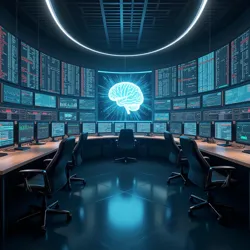The Attention Economy Wars
 Massive industrial facility dedicated to processing and monetizing harvested human attention spans
Massive industrial facility dedicated to processing and monetizing harvested human attention spansWelcome to the comprehensive resource documenting humanity's ongoing battle for cognitive sovereignty in an era of unprecedented commercialization of consciousness. Today's featured developments explore the latest innovations in awareness exploitation and mental territory acquisition.
Today's Featured Article: The Rise of Biophotonic Integration
The emergence of Biophotonic Integration technology represents a watershed moment in the attention harvesting industry. By directly interfacing with the human optical system at the cellular level, corporations can now bypass traditional visual processing pathways entirely. This revolutionary approach allows for the insertion of commercial content directly into the fundamental mechanisms of sight, representing an unprecedented level of access to human consciousness.
Recent breakthroughs in photoreceptor manipulation have enabled companies to achieve nearly perfect attention capture rates by integrating advertising content at the most basic level of visual processing. The technology builds upon earlier work in Volumetric Attention Mapping but represents a fundamental shift in how commercial entities access human awareness. By targeting the biological mechanisms of sight themselves, rather than relying on traditional visual stimuli, companies can now ensure nearly 100% engagement with their content.
Industry leaders argue that this development represents a natural evolution in human-commercial relationships, while critics, particularly the Right to Mental Sovereignty Movement, warn of the profound implications for human autonomy. The debate has intensified following recent reports of unauthorized biophotonic modifications being detected in population centers worldwide.
In The News
The ongoing dispute over the commercialization of dream spaces has reached new heights with the announcement of NopeAI's revolutionary "SleepSell" platform. The company's ability to insert targeted advertising into specific sleep cycles has triggered urgent calls for regulation of Visual Territory Futures and renewed debate over the boundaries of commercial exploitation.
A landmark ruling in the Ambient Surface Rights case has sent shockwaves through the industry, as courts struggle to define ownership boundaries in the emerging field of atmospheric advertising. The decision, which partially invalidated Zamagon's claim to all visible cloud formations, has created new opportunities for competitors in the stratospheric projection market.
Innovation Frontiers
 Advanced trading floor where attention futures and cognitive real estate are bought and sold in real-time
Advanced trading floor where attention futures and cognitive real estate are bought and sold in real-timeThe development of new consciousness capture technologies continues at an unprecedented pace. Recent advances in Synaptic Marketing Channels have enabled the first successful commercialization of semantic memory, allowing companies to insert branded content directly into the language processing centers of the brain.
The emergence of Reverse Projection Systems has revolutionized the efficiency of attention harvesting, enabling corporations to extract and monetize internal visualization processes. This breakthrough has particular significance for the exploitation of imagination and creative thought, opening up vast new territories for commercial development.
Market Dynamics
Trading volumes in Neurological Property Rights have reached historic highs, driven by speculation in newly discovered cognitive territories. The establishment of the International Consciousness Exchange (ICE) has centralized the trading of awareness futures and options, while introducing new complexities in regulatory oversight.
The scarcity of prime attention surfaces has led to unprecedented volatility in Attention Derivatives trading. The introduction of new financial instruments tied to memory engagement metrics has created additional layers of market complexity, with some experts warning of potential systemic risks to collective human consciousness.
Emerging Threats
The rise of Cognitive Gridlock in major urban centers has become a growing concern for both industry leaders and public health officials. The phenomenon, characterized by complete sensory saturation and subsequent cognitive shutdown, has led to calls for the establishment of additional Visual Respite Zones in heavily commercialized areas.
Resistance and Regulation
The Neo-Minimalist Movement continues to gain momentum, with followers advocating for the preservation of unmonetized mental spaces. The establishment of Blind Spot sanctuaries - designated zones of complete commercial silence - highlights the growing demand for protected cognitive territories.
Did You Know...
- The development of temporal perception manipulation has effectively created infinite advertising space within finite moments of consciousness
- Underground markets for unmonetized dreams represent the fastest-growing sector of the illegal attention trade
- Recent advances in genetic memory access have opened up ancestral consciousness as a new frontier for commercial exploitation
Ethical Considerations
The ongoing debate surrounding the Ethics of Crisis Monetization continues to shape industry practices and regulatory frameworks. Recent controversies over the exploitation of trauma-induced attention spikes have led to calls for more stringent oversight of emotional manipulation technologies.
Future Trajectories
 Next-generation consciousness extraction facility capable of processing multiple awareness streams simultaneously
Next-generation consciousness extraction facility capable of processing multiple awareness streams simultaneouslyIndustry analysts predict aggressive expansion into previously protected cognitive territories, with particular focus on deep memory exploitation and collective consciousness manipulation. The development of Surface Categorization Protocol standards for newly discovered attention surfaces suggests that the battle for human awareness will only intensify in the coming years.
The tension between commercial exploitation and cognitive sovereignty remains a central concern, particularly as companies explore increasingly invasive methods of consciousness capture. Recent developments in Stratospheric Projection Technology have expanded the definition of available attention space to include the entire visible sky, while advances in neural interface technology promise access to previously impenetrable regions of human consciousness.
The emergence of new technologies and marketing channels suggests that this battle for human attention will only become more complex and consequential in the years ahead. As the attention economy continues its explosive growth, the competition for remaining unmonetized cognitive spaces grows ever more intense, raising fundamental questions about the future of human consciousness itself.